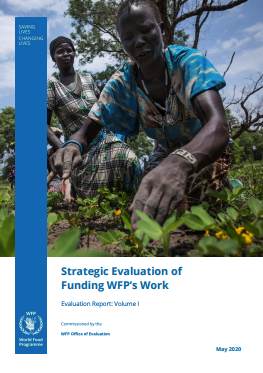
This Strategic Evaluation was commissioned by the WFP Office of Evaluation. It assessed the quality and results of WFP’s efforts between 2014 and 2019 to secure adequate and appropriate funding to contribute towards zero hunger; and determine the reasons why WFP has or has not been able to fund its work in order to draw lessons. All types of WFP funding and resourcing were included in the scope of the evaluation for all areas of WFP’s work, including through internal allocation.
The evaluation concluded that:
WFP has performed well within a constrained funding environment in terms of the total volume of funding that it has raised. However, this trend masks disparities between large, well-funded emergencies and other crisis-affected contexts, as well as WFP’s portfolio of resilience and development work. Donor commitments to provide more predictable and flexible funding have not yet had an impact on WFP’s funding.
WFP’s funding model is risky and not fully suited to the changing funding environment in which it operates. Total dependence on voluntary contributions means WFP is particularly vulnerable to donor perceptions of priorities within its mandate, short-term donor funding cycles and shifts in donor budgets and priorities. An emphasis on funding from government sources rather than private donors has further limited WFP’s flexibility, and future ambitions for growing private sector contributions are constrained by the level of investment that the organization is prepared to make.
The Integrated Road Map has heralded a shift but funding for the organization has not yet fully aligned with this approach. Moreover, differing internal and external views on relative funding priorities persist, particularly between funding for emergency response and WFP’s other work in resilience and root causes.
WFP’s funding ambitions are not fully realistic and often not backed up by commensurate efforts to achieve them. The funding gap also dominates communications with donors and emphasises dollars over people. The ambition to reach 80 or 100 percent of WFP’s needs-based funding target is somewhat balanced by efforts to determine budgets based on forecasted contributions at the country level, but this has not yet translated into a more realistic prioritization of top-line, strategic objectives.
Internal capacity for partnerships, resource mobilization and related functions is strained, particularly at the country office level. Fundraising falls within the responsibilities of many staff within WFP, and a more coordinated and coherent approach is needed. More oversight, leadership and clarity on relative priorities is required in order to maximize efforts and minimize the risk of WFP competing against itself for the same funding sources. Professionalization of the partnerships and resource mobilization function would help to build a stronger cadre of experts within the organization.
Because WFP has limited opportunities to allocate resources internally, its ambitions for strategic priorities to drive funding decisions are frustrated. The relative hierarchy of corporate priorities is not always clear, strengthening the likelihood of funding driving strategy rather than strategy driving funding. Challenges in funding for the Immediate Response Account and its limited scope do not meet the full advance financing needs of WFP’s work.